What We’re Reading: July 6th
Review: Plasmodesmata- form and function ($)
 Plasmodesmata are cell-cell junctions forming cytosolic bridges between neighbouring plant cells that provide an essential avenue for intercellular communication during a multitude of developmental and stress-related responses throughout the plant kingdom. In a recent ‘at a glance’ mini-review article, Sager and Lee discuss our current knowledge on both the form and function of these junctions, from plasmodesmatal development/complexity to their role as gatekeepers during long-distance signaling during stress. Further, the authors review current methodologies used to explore plasmodesmata biology and discuss accumulating evidence on plasmodesmata-like channels in animals and bacteria that suggest a broad role for cytosolic channels in mediating cell-cell communication. (Summary by Phil Carella) J. Cell Science 10.1242/jcs.209346
Plasmodesmata are cell-cell junctions forming cytosolic bridges between neighbouring plant cells that provide an essential avenue for intercellular communication during a multitude of developmental and stress-related responses throughout the plant kingdom. In a recent ‘at a glance’ mini-review article, Sager and Lee discuss our current knowledge on both the form and function of these junctions, from plasmodesmatal development/complexity to their role as gatekeepers during long-distance signaling during stress. Further, the authors review current methodologies used to explore plasmodesmata biology and discuss accumulating evidence on plasmodesmata-like channels in animals and bacteria that suggest a broad role for cytosolic channels in mediating cell-cell communication. (Summary by Phil Carella) J. Cell Science 10.1242/jcs.209346
Review: Models and mechanisms of stomatal mechanics ($)
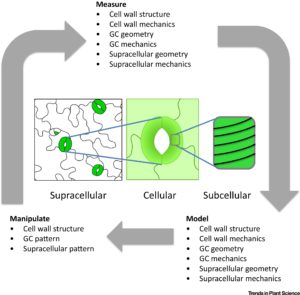 Guard cells are undoubtedly fascinating and frequently reviewed in terms of both their developmental programming and the intracellular signals that contribute to their function. This review, by Woolfenden, Baillie et al., covers a less familiar topic, that of the biophysical constraints to the mechanics of their action. The authors describe how the analysis of cell wall composition, mutants, and nanoindentation studies (using atomic force microscopy) to assess guard cells mechanical properties can be combined with finite element analysis and other modeling approaches in order to assess the role of wall stiffness on stomatal mechanics. Combining these tools leads to a systems approach of measure / model / manipulate, further provided new understandings of stomatal mechanics. Trends Plant Science (Summary by Mary Williams) 10.1016/j.tplants.2018.06.003
Guard cells are undoubtedly fascinating and frequently reviewed in terms of both their developmental programming and the intracellular signals that contribute to their function. This review, by Woolfenden, Baillie et al., covers a less familiar topic, that of the biophysical constraints to the mechanics of their action. The authors describe how the analysis of cell wall composition, mutants, and nanoindentation studies (using atomic force microscopy) to assess guard cells mechanical properties can be combined with finite element analysis and other modeling approaches in order to assess the role of wall stiffness on stomatal mechanics. Combining these tools leads to a systems approach of measure / model / manipulate, further provided new understandings of stomatal mechanics. Trends Plant Science (Summary by Mary Williams) 10.1016/j.tplants.2018.06.003
Calcium-mediated ABA signaling negatively regulated by CBL-CIPK system in guard cells
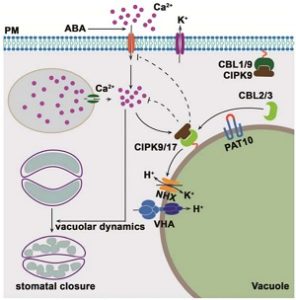 Abscisic acid (ABA) plays a critical role in the opening and closing of the stomatal pore. This stomatal movement is essential for homeostasis, photosynthesis and stress responses. An influx of calcium ions and an increase the cytoplasmic calcium concentration of the guard cells are an early event in ABA signaling. It is not clear what the negative regulators of this process are and how calcium connects with potassium ion fluxes and vacuolar convolution. Song and colleagues used Arabidopsis thaliana mutants to examine the role of ABA and calcium in stomatal movement though phenotypic studies. The null mutant of Protein S-Acyl Transferase 10 (pat10-1) is hypersensitive to ABA-induced stomatal closure and vacuolar convolution. PAT10 is essential for the tonoplast association of Calcineurin B-Like protein 2 (CBL2) and CBL3. Loss of CBL2 and CBL3 results in plants that have phenotypes similar to pat10-1. CBL-Interacting Protein Kinase 9 (CIPK9) and CIPK17 were also identified as proteins that interact with the PAT10-CBL2/CBL3 system. Loss of PAT10-CBL2/3-CIPK9/17 system increases the drought tolerance of Arabidopsis. The PAT10-CBL2/CIPK3-CIPK9/17 system positively regulates vacuolar potassium ion accumulation and negatively regulates calcium-mediated ABA signaling. (Summary by Julia Miller) Plant Physiol. 10.1104/pp.18.00377
Abscisic acid (ABA) plays a critical role in the opening and closing of the stomatal pore. This stomatal movement is essential for homeostasis, photosynthesis and stress responses. An influx of calcium ions and an increase the cytoplasmic calcium concentration of the guard cells are an early event in ABA signaling. It is not clear what the negative regulators of this process are and how calcium connects with potassium ion fluxes and vacuolar convolution. Song and colleagues used Arabidopsis thaliana mutants to examine the role of ABA and calcium in stomatal movement though phenotypic studies. The null mutant of Protein S-Acyl Transferase 10 (pat10-1) is hypersensitive to ABA-induced stomatal closure and vacuolar convolution. PAT10 is essential for the tonoplast association of Calcineurin B-Like protein 2 (CBL2) and CBL3. Loss of CBL2 and CBL3 results in plants that have phenotypes similar to pat10-1. CBL-Interacting Protein Kinase 9 (CIPK9) and CIPK17 were also identified as proteins that interact with the PAT10-CBL2/CBL3 system. Loss of PAT10-CBL2/3-CIPK9/17 system increases the drought tolerance of Arabidopsis. The PAT10-CBL2/CIPK3-CIPK9/17 system positively regulates vacuolar potassium ion accumulation and negatively regulates calcium-mediated ABA signaling. (Summary by Julia Miller) Plant Physiol. 10.1104/pp.18.00377
Rapid and reversible root growth inhibition by TIR1 auxin signalling
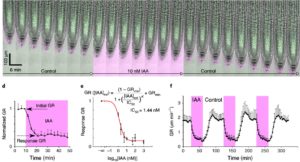 Auxin mediates many of its effects through transcriptional changes via the well-known interaction between its co-receptors and transcriptional regulators (TIR1/AFB – Aux/IAA), but some auxin responses happen too quickly to be explained by transcriptional changes. Fendrych et al. demonstrate that root growth rate slows within 30 seconds of auxin application, and accelerates within 2 minutes of auxin removal. They show that these rapid responses depend on the auxin influx carrier AUX1, suggesting that the growth response is mediated by intracellular auxin. Through inhibitor, mutant and artificial ligand studies, they show that the growth effect is mediated by interaction between auxin and TIR1, which “implies that this canonical signalling pathway regulates root growth via an unknown, non-transcriptional signalling branch.” (Summary by Mary Williams) Nature Plants 10.1038/s41477-018-0190-1
Auxin mediates many of its effects through transcriptional changes via the well-known interaction between its co-receptors and transcriptional regulators (TIR1/AFB – Aux/IAA), but some auxin responses happen too quickly to be explained by transcriptional changes. Fendrych et al. demonstrate that root growth rate slows within 30 seconds of auxin application, and accelerates within 2 minutes of auxin removal. They show that these rapid responses depend on the auxin influx carrier AUX1, suggesting that the growth response is mediated by intracellular auxin. Through inhibitor, mutant and artificial ligand studies, they show that the growth effect is mediated by interaction between auxin and TIR1, which “implies that this canonical signalling pathway regulates root growth via an unknown, non-transcriptional signalling branch.” (Summary by Mary Williams) Nature Plants 10.1038/s41477-018-0190-1
Capturing auxin response factors syntax using DNA binding models
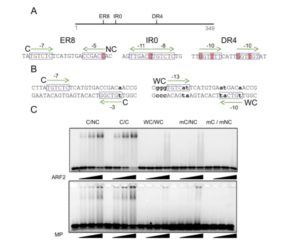 Auxin Response Factors (ARFs) are transcription factors that bind to ARF binding sites (ARFbs) to mediate auxin responses. Stigliani et al. analzyed experimentally determined DNA interactions of two ARFs, the repressor ARF2 and the activator MP. They found that the binding site data are best interpreted using a position weight matrix (PWM). Using this method, they showed small differences in monomeric binding site preferences between the two proteins, but larger differences in how these sites are arranged (e.g., direct repeat, inverted repeat, everted repeat). Their method also enabled them to identify binding sites not found through the use of consensus sequences. (Summary by Mary Williams) bioRxiv
Auxin Response Factors (ARFs) are transcription factors that bind to ARF binding sites (ARFbs) to mediate auxin responses. Stigliani et al. analzyed experimentally determined DNA interactions of two ARFs, the repressor ARF2 and the activator MP. They found that the binding site data are best interpreted using a position weight matrix (PWM). Using this method, they showed small differences in monomeric binding site preferences between the two proteins, but larger differences in how these sites are arranged (e.g., direct repeat, inverted repeat, everted repeat). Their method also enabled them to identify binding sites not found through the use of consensus sequences. (Summary by Mary Williams) bioRxiv
Tomato fruit localized phytochromes regulate chloroplast biogenesis, starch synthesis and carotenoid metabolism
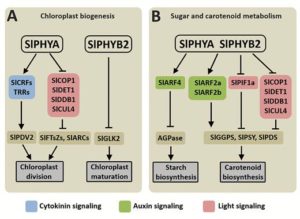 The earliest report about the influence of light quality in tomato fruit biology dates back to 1954, in which it was shown that red /far red light regulates fruit pigmentation reversibly. Using fruit-specific RNAi silencing of SlPHYA, SlPHYB2 or SlPHYB1/B2, Bianchetti and co-workers have shown the different roles of these fruit-localized phytochromes. The plastids of the SlPHYA knockdown contained reduced grana compared to the WT or the other knockdowns during early fruit development. Also, the level of starch and expression of genes related to starch biosynthesis was higher in SlPHYA and SlPHYB2 knockdowns compared to the WT. Lycopene content was also reduced in SlPHYA and SlPHYB2 knockdowns and further analysis showed that the levels of transcripts for carotenoid biosynthesis were reduced.(Summary by Cecilia Vasquez-Robinet) J. Exp. Bot. 10.1093/jxb/ery145
The earliest report about the influence of light quality in tomato fruit biology dates back to 1954, in which it was shown that red /far red light regulates fruit pigmentation reversibly. Using fruit-specific RNAi silencing of SlPHYA, SlPHYB2 or SlPHYB1/B2, Bianchetti and co-workers have shown the different roles of these fruit-localized phytochromes. The plastids of the SlPHYA knockdown contained reduced grana compared to the WT or the other knockdowns during early fruit development. Also, the level of starch and expression of genes related to starch biosynthesis was higher in SlPHYA and SlPHYB2 knockdowns compared to the WT. Lycopene content was also reduced in SlPHYA and SlPHYB2 knockdowns and further analysis showed that the levels of transcripts for carotenoid biosynthesis were reduced.(Summary by Cecilia Vasquez-Robinet) J. Exp. Bot. 10.1093/jxb/ery145
The PILNCR1-miR399 regulatory module is important for low-phosphate tolerance in maize
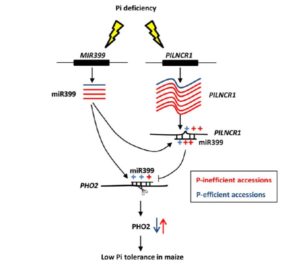 Nearly ten years ago, microRNA 399 (miR399) was recognized as a regulator of phosphate (Pi) homeostasis. miR399 expression is induced upon low Pi conditions, and, in Arabidopsis, rice, soybean and barley, miR399 suppresses PHO2, a negative regulator of Pi uptake. Du, Wang, Zou et al. found that contrary to previous indications, PHO2 is also a target for miR399 in maize. Interestingly though, in response to low Pi conditions the transcripts of ZmPHO2 were downregulated in P-efficient lines but up-regulated in P-inefficient lines. The authors identified a long non-coding RNA, PILNCR1, with a complementary region to miR399 that is highly expressed in P-inefficient accessions. The authors propose that this long non-coding RNA inhibits miR399-guided cleavage of PHO2, affecting tolerance to low Pi. (Summary by Mary Williams) Plant Physiol. 10.1104/pp.18.00034
Nearly ten years ago, microRNA 399 (miR399) was recognized as a regulator of phosphate (Pi) homeostasis. miR399 expression is induced upon low Pi conditions, and, in Arabidopsis, rice, soybean and barley, miR399 suppresses PHO2, a negative regulator of Pi uptake. Du, Wang, Zou et al. found that contrary to previous indications, PHO2 is also a target for miR399 in maize. Interestingly though, in response to low Pi conditions the transcripts of ZmPHO2 were downregulated in P-efficient lines but up-regulated in P-inefficient lines. The authors identified a long non-coding RNA, PILNCR1, with a complementary region to miR399 that is highly expressed in P-inefficient accessions. The authors propose that this long non-coding RNA inhibits miR399-guided cleavage of PHO2, affecting tolerance to low Pi. (Summary by Mary Williams) Plant Physiol. 10.1104/pp.18.00034
Of puzzles and pavements: a quantitative exploration of leaf epidermal cell shape
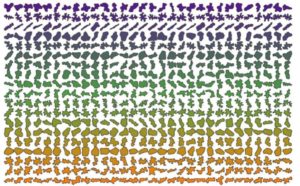 Arabidopsis plants have epidermal pavement cells (the cells that make up the bulk of the epidermis, other than guard cells or trichomes) that are often described as “jigsaw puzzle” shaped, and, because Arabidopsis is such a useful model organism, we have nice models for how these distinctive shapes are formed. However, are they ubiquitous? Vofely et al. analyzed pavement cells from 278 vascular plant species (ferns, gymnosperms and angiosperms) and found that most species do not show this cell shape; in fact, “most vascular plants have slightly elliptical pavement cells with weakly undulating margins”. This study demonstrates how studies beyond model systems enrich and challenge our understanding of plant science. (Summary by Mary Williams) bioRxiv 10.1101/361717
Arabidopsis plants have epidermal pavement cells (the cells that make up the bulk of the epidermis, other than guard cells or trichomes) that are often described as “jigsaw puzzle” shaped, and, because Arabidopsis is such a useful model organism, we have nice models for how these distinctive shapes are formed. However, are they ubiquitous? Vofely et al. analyzed pavement cells from 278 vascular plant species (ferns, gymnosperms and angiosperms) and found that most species do not show this cell shape; in fact, “most vascular plants have slightly elliptical pavement cells with weakly undulating margins”. This study demonstrates how studies beyond model systems enrich and challenge our understanding of plant science. (Summary by Mary Williams) bioRxiv 10.1101/361717
The Phytophthora RXLR effector AVR3a12 suppresses ER-mediated plant immunity
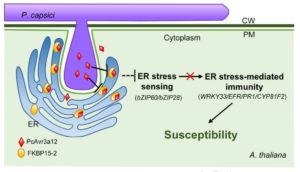 The pathogenic oomycete Phytophthora capsici secretes RXLR effector proteins into plant cells to subvert host cell machinery and facilitate disease. Several RXLR effector proteins have been characterized to date, however, Phytophthora species encode a vast array of effector molecules that likely target different cellular compartments during infection. In a recent article in Molecular Plant, Fan et al. (2018) characterize the role of a Phytophthora capsici RXLR effector (PcAVR3a12) during infection in Arabidopsis thaliana. The authors discovered that PcAVR3a12 specifically targets the ER-localized peptidyl-prolyl cis-trans isomerase (PPIase) FKBP15-2. Disease assays and expression studies using knockout and overexpression lines demonstrated a pivotal role for FKBP15-2 in the positive regulation of plant immunity via an ER-stress sensing network involving bZIP transcription factors. Taken together, the data presented by Fan et al. provide further support for an important stress sensory system in the plant endoplasmic reticulum whose function is subverted by a pathogen effector in order to promote microbial fitness in planta. (Summary by Phil Carella) Mol. Plant 10.1016/j.molp.2018.05.009
The pathogenic oomycete Phytophthora capsici secretes RXLR effector proteins into plant cells to subvert host cell machinery and facilitate disease. Several RXLR effector proteins have been characterized to date, however, Phytophthora species encode a vast array of effector molecules that likely target different cellular compartments during infection. In a recent article in Molecular Plant, Fan et al. (2018) characterize the role of a Phytophthora capsici RXLR effector (PcAVR3a12) during infection in Arabidopsis thaliana. The authors discovered that PcAVR3a12 specifically targets the ER-localized peptidyl-prolyl cis-trans isomerase (PPIase) FKBP15-2. Disease assays and expression studies using knockout and overexpression lines demonstrated a pivotal role for FKBP15-2 in the positive regulation of plant immunity via an ER-stress sensing network involving bZIP transcription factors. Taken together, the data presented by Fan et al. provide further support for an important stress sensory system in the plant endoplasmic reticulum whose function is subverted by a pathogen effector in order to promote microbial fitness in planta. (Summary by Phil Carella) Mol. Plant 10.1016/j.molp.2018.05.009
Bioinformatics core competencies for undergraduate life sciences education
 Undergraduate life science curricula need to incorporate training in bioinformatics. Wilson Sayres et al. surveyed 1260 faculty from across the US to identify their thoughts on what such training should involve. Not surprisingly, 95% of those surveyed agreed with the statement “I think bioinformatics should be integrated into undergraduate life sciences education.” The article defines a set of nine core competencies that emerge from these responses. The authors also recommend that training in these skills be distributed across the curriculum rather than being taught as a single, isolated course. (Summary by Mary Williams) PLOS One 10.1371/journal.pone.0196878
Undergraduate life science curricula need to incorporate training in bioinformatics. Wilson Sayres et al. surveyed 1260 faculty from across the US to identify their thoughts on what such training should involve. Not surprisingly, 95% of those surveyed agreed with the statement “I think bioinformatics should be integrated into undergraduate life sciences education.” The article defines a set of nine core competencies that emerge from these responses. The authors also recommend that training in these skills be distributed across the curriculum rather than being taught as a single, isolated course. (Summary by Mary Williams) PLOS One 10.1371/journal.pone.0196878



